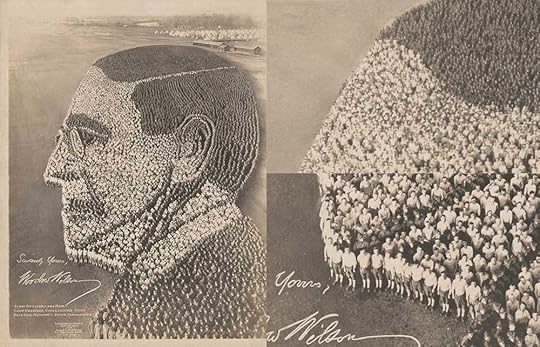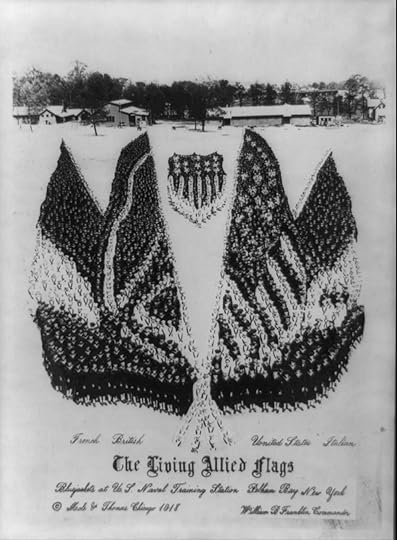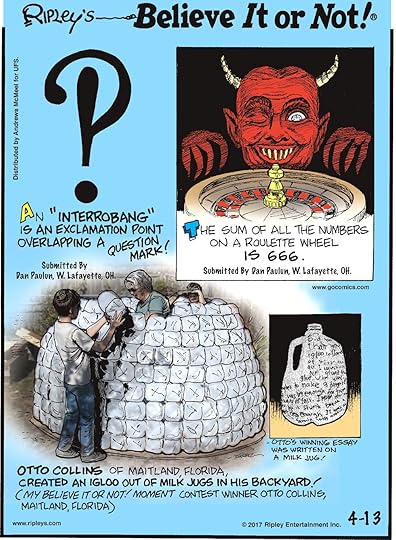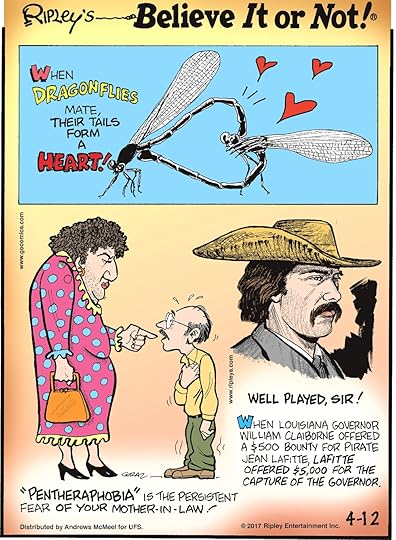Ripley Entertainment Inc.'s Blog, page 417
April 13, 2017
Mr. Trash Wheel Is a Solar Powered Garbage-Eating Robot
Featured in Ripley's Believe It or Not!

Mr. Trash Wheel is the product of Baltimore’s Waterfront Partnership and uses solar power to collect trash out of the Jone Falls River.
A paddle wheel attached to a conveyor belt use a combination of the river’s current and solar energy to lift garbage out of the water and into a dumpster.
When the dumpster fills up, a boat tows it away and replaces it with a new one. Despite its simplicity, the machine has been massively successful.
Since May 2014, the robot has collected over one million pounds of garbage from the water.
Becoming a Celebrity
The trash collecting water wheel got it’s first googly eyes in 2015, and was propelled into instant stardom as Mr. Trash Wheel. Originally meant to be temporary, a petition signed by over 1,500 supporters made the eyes permanent.
Mr. Trash Wheel has since gotten his own Twitter and Facebook pages, along with T-shirts and his own beer label.

Mr. Trash Wheel’s Diet
372,650 plastic bottles
464,947 styrofoam containers
8,965,600 cigarette butts
6,478 glass bottles
257,337 grocery bags
346,149 chip bags
There’s no doubt Mr. Trash Wheel has eaten a lot of everyday trash, but he’s also had his fair share of exotic cuisine.
He’s picked up beer kegs, tires, a still-frozen carton of strawberry ice cream, and even a ball python—which was later adopted.
Starting in 2015, the collected trash began going to waste to energy plants and is responsible for collecting enough waste to power 5,400 homes.
More Mr. Trash Wheels
The inventor of Mr. Trash Wheel, Clearwater Mills, says they’re looking to install Mr. Trash Wheels in other places around the country. A “Professor Trash Wheel” was even developed that’s a lighter, more agile form of the trash collector.
There are rumors of a third wheel, but the company is tight-lipped on what its identity might be.
“It’s way too early to start thinking about naming and googly eyes. I don’t know what relationship this trash wheel will have to Professor or Mr. Trash Wheel, but I look forward to finding out.” – Adam Lindquist, initiative director.
Source: Mr. Trash Wheel Is a Solar Powered Garbage-Eating Robot
CARTOON 04-13-2017
April 12, 2017
Longyearbyen: The Town that Bans Death
Featured in Ripley's Believe It or Not!

In the town of Longyearbyen, Norway, death is not allowed. If you’re sick or dying, they send you to the mainland, and, if you do happen to die in town, no one will bury you.
The town has had this policy in place for nearly 80 years, and the cemetery has been closed since 1918.
Reasons
Temperatures in Longyearbyen drop below -50˚ Fahrenheit, and the permafrost is thick. After burying bodies at the turn of the century, townspeople soon realized that the bodies simply weren’t decomposing. Bodies in the cemetery were so well preserved, that scientists found living traces of the Spanish flu pandemic still alive in Longyearbyen’s cemetery.
Spanish Flu
The Spanish flu was thought to have been eradicated shortly after World War I and is thought to be responsible for the deaths of 80 million people.
When scientists refer to the “100-year super bug”, the Spanish flu was the last one. Since the flu burned itself out before modern medicine could study it, however, treatment for the disease is still unknown. The samples recovered from Longyearbyen graves have actually given scientists a new opportunity to find ways to fight the disease.
The arctic town was completely unaware of the disease still sitting in their cemetery for close to 100 years. This led them to double-down on their no-death policy.
CARTOON 04-12-2017
April 11, 2017
WWI’s Living Photographs Used Thousands of Soldiers to Unite America
Featured in Ripley's Believe It or Not!

Photographer Arthur Mole was born in Lexen, Essex, England in 1889. After making his way to America in 1903, he became renown for his “living photographs” which used tens of thousands of soldiers to create patriotic photos during World War I.
Using up to 30,000 soldiers, in a variety of uniforms with hats on, hats off, and white shirts, he created stunning displays of America’s military organization and might.

30,000 soldiers assembled to make this US shield.
A group photo pioneer, Mole’s photos weren’t as simple as organizing troops and snapping a drone photo. His photos rely heavily on the point of view. If viewed from directly above, the shapes are unrecognizable.
How It Was Done
Mole would climb to the top of a 75-foot tower, and take the photo at an angle. As the depth of his chosen portrait grew, so did the number of people needed to portray them. For example, because the front row was closer to the camera, it required fewer people, while the back row could require thousands of people to portray an equal portion of the photograph.

Woodrow Wilson made from 21,000 soldiers.
Each photo took months to prepare, with careful planning and testing required to make the shots work.
From his tower, the conscientious photographer would direct the thousands of soldiers below using a megaphone and stick.
He traveled to 18 different military installations to create these photos, which were meant to fight isolationist sentiment during the Great War.
Many soldiers complained about being in the photos, Navy officers were forced into white summer uniforms in the cold, and army officers were made to stand for hours in over 100-degree heat.

US Naval insignia
Influences to this Day
A symbol of collective will, many communist and fascist regimes would later be inspired by the symbolism in Arthur Mole’s work. The German display at the Olympic games in 1936, for example, are reminiscent of Mole’s living photographs.

The living allied flags.
The influence of living photographs lives on to this day in the US military, with sailors forming “Nice to meet you!” in Japanese on the deck of the USS George Washington in 2008.

Hajimemashite (Nice to meet you)
Source: WWI’s Living Photographs Used Thousands of Soldiers to Unite America
CARTOON 04-11-2017
April 10, 2017
Hospital Releases CPR Playlist to Help Save Lives
Featured in Ripley's Believe It or Not!

New York-Presbyterian Hospital released a CPR playlist on their website to help people maintain rhythm while performing CPR.
While they don’t want people to delay urgent rescue to put their earbuds in, the hospital hopes the playlist will help keep CPR practitioners’ compressions at the proper rhythm.
The Science
The songs all maintain a tempo between 100 and 120 beats per minute, which is about the number of compressions recommended for adults by the American Red Cross and Mayo Clinic. In a bit of fun, they chose the Bee Gee’s Stayin’ Alive to top their list.
The Red Cross calls for 2-inch-deep compressions and suggests leveraging your body weight, and that’s on top of performing rescue breaths. All of that can be incredibly taxing on the body.
As a potential rescuer grows tired, they can lose vigor and slow the rate of compression, drastically reducing the effectiveness of their CPR. By pushing along to the beat of a well-known song, clinicians think they can improve compression consistency.
Proof
Further study by the American Heart Association had paramedics listen to Disco Science and Achy Breaky Heart while performing chest compressions. Both groups were able to maintain the proper rate of compression better than the control group.
To make sure everyone knows a song in the right 100-120 range, Man In the Mirror, Girl’s Just Want to Have Fun, and Another One Bites the Dust were also included.
“We wanted them to be popular songs. We wanted them to be songs that people already knew by heart.” –Alaina Paciulli, Seiden Advertising
CARTOON 04-10-2017
April 9, 2017
CARTOON 04-09-2017
April 8, 2017
CARTOON 04-08-2017
Ripley Entertainment Inc.'s Blog
- Ripley Entertainment Inc.'s profile
- 52 followers









